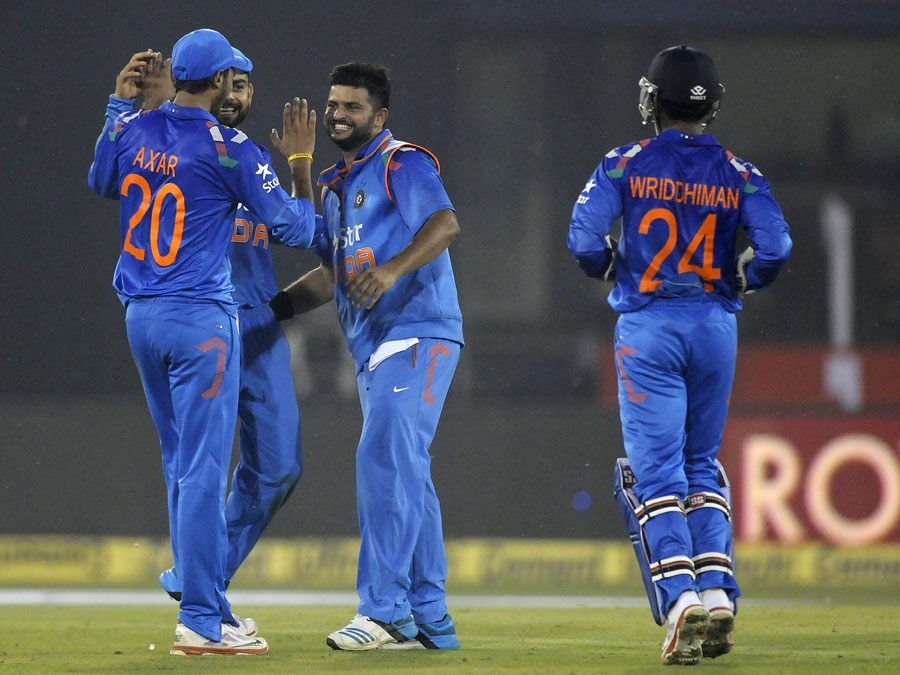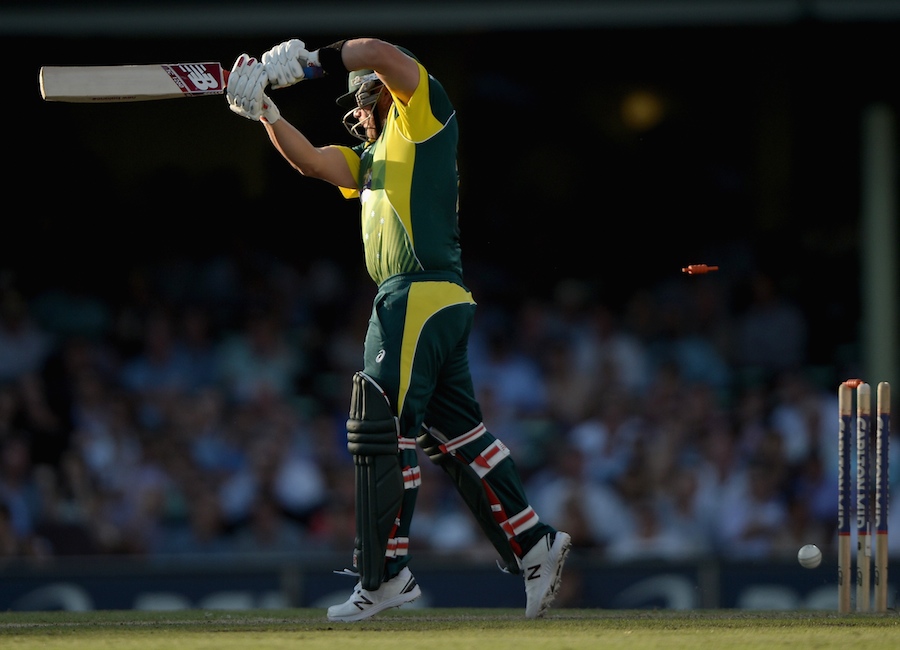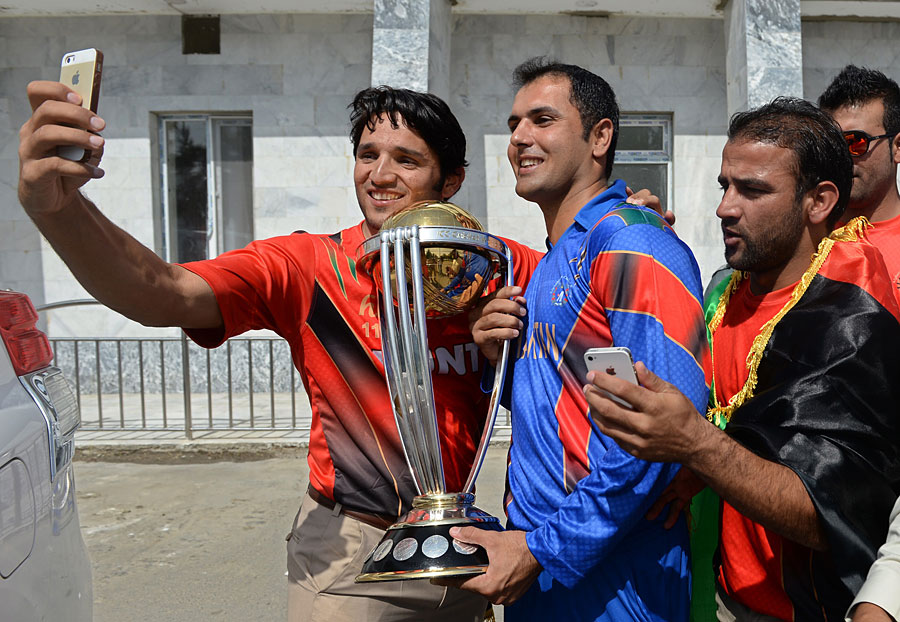1. Fielding restrictions and Powerplays
In 2012, the ICC made a number of alterations to the playing conditions for ODIs. The one that will likely have the most noticeable effect at this World Cup is the change from a maximum of five to four fielders outside the 30-yard circle for the majority of the innings. There will also be two blocks of Powerplay overs rather than three: the first covering the opening ten overs, when only two fielders are allowed outside the ring; the second, a five-over block to be taken by the batting side before the 40th over, restricting the number to three outside the ring.
In 2012, the ICC made a number of alterations to the playing conditions for ODIs. The one that will likely have the most noticeable effect at this World Cup is the change from a maximum of five to four fielders outside the 30-yard circle for the majority of the innings. There will also be two blocks of Powerplay overs rather than three: the first covering the opening ten overs, when only two fielders are allowed outside the ring; the second, a five-over block to be taken by the batting side before the 40th over, restricting the number to three outside the ring.
2. Two new balls
The move to a new ball being used from each end came about shortly after the previous World Cup, in late 2011. Previously the white ball, which is prone to degradation, was changed after 34 overs (although not for a new one). Providing two new balls has made batting more challenging for openers in conditions that assist quick bowlers but also preserves the hardness throughout the innings, meaning faster run-scoring later on. It also means reverse swing will likely be less of a feature.
The move to a new ball being used from each end came about shortly after the previous World Cup, in late 2011. Previously the white ball, which is prone to degradation, was changed after 34 overs (although not for a new one). Providing two new balls has made batting more challenging for openers in conditions that assist quick bowlers but also preserves the hardness throughout the innings, meaning faster run-scoring later on. It also means reverse swing will likely be less of a feature.
3. Reduced role for part-timers
The first two factors are likely to affect the balance of sides at this World Cup. Rahul Dravid has suggested there will be less leeway for part-time bowlers than four years ago, when India regularly got ten overs out of Yuvraj Singh, due to the lack of protection. The 1992 World Cup was the heyday of wobbly seam-up but even New Zealand are more focused on genuine pace these days, with specialists expected to shoulder the bulk of the workload in most attacks.
The first two factors are likely to affect the balance of sides at this World Cup. Rahul Dravid has suggested there will be less leeway for part-time bowlers than four years ago, when India regularly got ten overs out of Yuvraj Singh, due to the lack of protection. The 1992 World Cup was the heyday of wobbly seam-up but even New Zealand are more focused on genuine pace these days, with specialists expected to shoulder the bulk of the workload in most attacks.

4. The swing to seam
Conditions as well as rule changes will contribute to a major shift from 2011, when spin bowling dominated. Australia is generally inhospitable to spinners and that gig has only got harder since the reduction in the number of fielders allowed outside the ring, making it more difficult for sides to defend the boundary. Assistance for seam and swing will be expected in New Zealand, with pace and bounce on the Australian menu - although the fact the World Cup is at the end of the summer, when pitches will likely have become worn, could yet prevent spin from being snuffed out entirely.
Conditions as well as rule changes will contribute to a major shift from 2011, when spin bowling dominated. Australia is generally inhospitable to spinners and that gig has only got harder since the reduction in the number of fielders allowed outside the ring, making it more difficult for sides to defend the boundary. Assistance for seam and swing will be expected in New Zealand, with pace and bounce on the Australian menu - although the fact the World Cup is at the end of the summer, when pitches will likely have become worn, could yet prevent spin from being snuffed out entirely.
5. The post-chucking environment
There is another shadow hanging over the spinners, however. The zeal with which the ICC has sought to eradicate illegal actions means even those who have not been called or have undergone remedial work will be wary. The No. 1-ranked ODI bowler, Saeed Ajmal, will be absent; Sunil Narine, currently No. 2, is included in West Indies' squad despite not having played internationally since being called in the Champions League; and Sachithra Senanayake is being eased back in by Sri Lanka after a ban. It may be up to Shahid Afridi, joint-leading wicket-taker in 2011, to fly the flag again.
There is another shadow hanging over the spinners, however. The zeal with which the ICC has sought to eradicate illegal actions means even those who have not been called or have undergone remedial work will be wary. The No. 1-ranked ODI bowler, Saeed Ajmal, will be absent; Sunil Narine, currently No. 2, is included in West Indies' squad despite not having played internationally since being called in the Champions League; and Sachithra Senanayake is being eased back in by Sri Lanka after a ban. It may be up to Shahid Afridi, joint-leading wicket-taker in 2011, to fly the flag again.
6. New kids on the block
This is not expected to be a tournament particularly high on those making their first World Cup appearances but there will be a host of fresh faces in the vanguard. Since India's players hoisted Sachin Tendulkar on to their shoulders and carried him around the Wankhede, several giants of the game have retired or been dispensed with. There will be no Jacques Kallis or Graeme Smith, no Virender Sehwag or Zaheer Khan, no Muttiah Muralitharan, no Ricky Ponting, no Kevin Pietersen. Instead, the likes of Virat Kohli, Corey Anderson, Aaron Finch, Mitchell Starc and Moeen Ali will take centre stage.
This is not expected to be a tournament particularly high on those making their first World Cup appearances but there will be a host of fresh faces in the vanguard. Since India's players hoisted Sachin Tendulkar on to their shoulders and carried him around the Wankhede, several giants of the game have retired or been dispensed with. There will be no Jacques Kallis or Graeme Smith, no Virender Sehwag or Zaheer Khan, no Muttiah Muralitharan, no Ricky Ponting, no Kevin Pietersen. Instead, the likes of Virat Kohli, Corey Anderson, Aaron Finch, Mitchell Starc and Moeen Ali will take centre stage.

7. The DRS
The ICC only confirmed what tools would form part of the DRS a week before the start of the tournament. Real-Time Snickometer, which had not been developed in 2011, is available this time but again there will be no Hot Spot. One thing that will be clearer from the outset is the process for reviewing lbw decisions via ball-tracking technology. Ian Bell's reprieve in Bangalore four years ago incensed India and forced the ICC to issue revised guidelines; that 2.5-metre rule is now set at 3 metres, beyond which not-out decisions cannot be overturned.
The ICC only confirmed what tools would form part of the DRS a week before the start of the tournament. Real-Time Snickometer, which had not been developed in 2011, is available this time but again there will be no Hot Spot. One thing that will be clearer from the outset is the process for reviewing lbw decisions via ball-tracking technology. Ian Bell's reprieve in Bangalore four years ago incensed India and forced the ICC to issue revised guidelines; that 2.5-metre rule is now set at 3 metres, beyond which not-out decisions cannot be overturned.
8. Increased prize money
The total pool of prize money on offer has been raised by 25% from US$8m to $10m for the 2015 tournament and the winning team could collect more than $4m, if they remain unbeaten. For the first time, the six nations who fail to make the quarter-finals will also be rewarded, to the tune of $35,000 each, with $45,000 also on offer for each group-stage win.
The total pool of prize money on offer has been raised by 25% from US$8m to $10m for the 2015 tournament and the winning team could collect more than $4m, if they remain unbeaten. For the first time, the six nations who fail to make the quarter-finals will also be rewarded, to the tune of $35,000 each, with $45,000 also on offer for each group-stage win.
9. No Super Overs in knockouts
In 2011, the ICC introduced the one-over eliminator - or Super Over - as the method of determining which team would progress in the event of a tie during the knockout stages. That replaced the Bowl Out from 2007, which had in turn superseded the method famously used to separate Australia and South Africa in 1999: group standings. Now things have gone full circle, with Super Overs dropped for all knockouts, except the final.
In 2011, the ICC introduced the one-over eliminator - or Super Over - as the method of determining which team would progress in the event of a tie during the knockout stages. That replaced the Bowl Out from 2007, which had in turn superseded the method famously used to separate Australia and South Africa in 1999: group standings. Now things have gone full circle, with Super Overs dropped for all knockouts, except the final.
10. Run rates
This one requires some theorising. The last World Cup was the first to have an average run rateof above five an over, going past the record of 4.95 set in 2007. Tighter fielding restrictions might suggest a continued upward trend, although a year after the regulations were tweaked, little had changed - in fact, armed with two new balls, bowlers had prospered in Australia and New Zealand. However, since the start of 2014, the average runs per over has ballooned to 5.32 in Australia and 5.66 in New Zealand. The dawning possibility of how quickly teams can score at the back of the innings, as evidenced by AB de Villiers' record-breaking hundred in Johannesburg, means this World Cup could be the most supercharged of all.
This one requires some theorising. The last World Cup was the first to have an average run rateof above five an over, going past the record of 4.95 set in 2007. Tighter fielding restrictions might suggest a continued upward trend, although a year after the regulations were tweaked, little had changed - in fact, armed with two new balls, bowlers had prospered in Australia and New Zealand. However, since the start of 2014, the average runs per over has ballooned to 5.32 in Australia and 5.66 in New Zealand. The dawning possibility of how quickly teams can score at the back of the innings, as evidenced by AB de Villiers' record-breaking hundred in Johannesburg, means this World Cup could be the most supercharged of all.
And one thing that will be the same...

11. The format
Days after the 2011 final, the ICC announced that the next two tournaments would be contested by ten teams, sparking protests from the Associate and Affiliate nations - in particular Ireland, whose feats had helped reinvigorate the event. That decision was duly reversed a few months later, meaning that there will again be two groups of seven from which the eight quarter-finalists will emerge. It may make things somewhat predictable but that is more a consequence of needing to guarantee the major teams a certain number of games for television. A slimmer 2019 World Cup may be sadly lacking in romance.
Days after the 2011 final, the ICC announced that the next two tournaments would be contested by ten teams, sparking protests from the Associate and Affiliate nations - in particular Ireland, whose feats had helped reinvigorate the event. That decision was duly reversed a few months later, meaning that there will again be two groups of seven from which the eight quarter-finalists will emerge. It may make things somewhat predictable but that is more a consequence of needing to guarantee the major teams a certain number of games for television. A slimmer 2019 World Cup may be sadly lacking in romance.

No comments:
Post a Comment